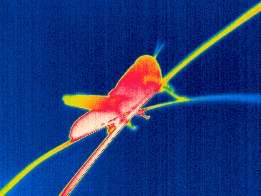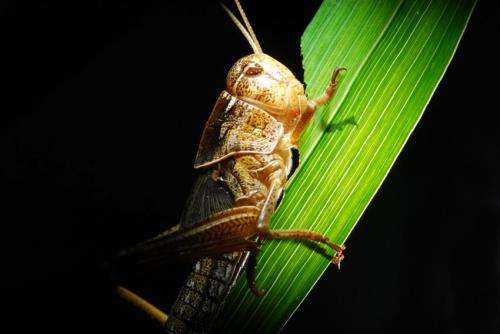Locusts harness the sun to get their optimum diet

If you are a locust, the most nutritious plant to eat depends on the ambient temperature. Scientists at the University of Sydney, Australia, have discovered that locusts choose their food and then where they digest it according to how hot it is.
Dr Fiona Clissold, who led the study, explains why temperature has such a large influence on insect diets. "Whilst an insect's metabolic rate increases exponentially with temperature, the rate at which locusts absorb protein and carbohydrate from different plants does not increase in step with temperature. As a result, nutrient availability at a given temperature varies between different plant species. A plant can be a poor quality diet at one temperature and a good quality diet at another."
The researchers used two species of grass that are commonly eaten by locusts in Australia. The first, Kangaroo grass, gives a high protein diet at high temperatures and a high carbohydrate diet at low temperatures. In wheat, the protein/carbohydrate ratio does not change with temperature, but locusts are able to absorb the nutrients more effectively at higher temperatures. Consequently, locusts raised on Kangaroo grass reach a larger size at low temperatures, but locusts that are fed wheat are larger at high temperatures. Intriguingly, when both plants are available, the locusts modify their behaviour to get the maximum benefit from the nutrients on offer. After eating, locusts sit for 30-40 minutes to digest their meal before feeding again. Following a meal of Kangaroo grass, the locusts seek shady places, such as behind grass stalks or in burrows, in order to get a high carbohydrate meal. After eating wheat, however, the locusts sit in warmer areas to ensure a protein-rich meal.
Dr Clissold adds "Being small, insects can take advantage of the multitude of microclimates available".
As mammals are warm-blooded animals that maintain a constant body temperature, it is unlikely that temperature overtly affects the nutrient quality of their diets. However, there is some evidence that rodents may increase their body temperature to reduce the toxicity of compounds found in some plant leaves.

It is hoped that the results from this study could be used to develop methods to control agricultural insect pests and predict when outbreaks may occur. Meanwhile, the researchers are currently investigating why plant quality varies with temperature and how climate change may affect dietary preferences of herbivorous insects.
This work is to be presented at the Society for Experimental Biology Annual Meeting 2014 in Manchester on Wednesday 2nd July.
Provided by Society for Experimental Biology





















